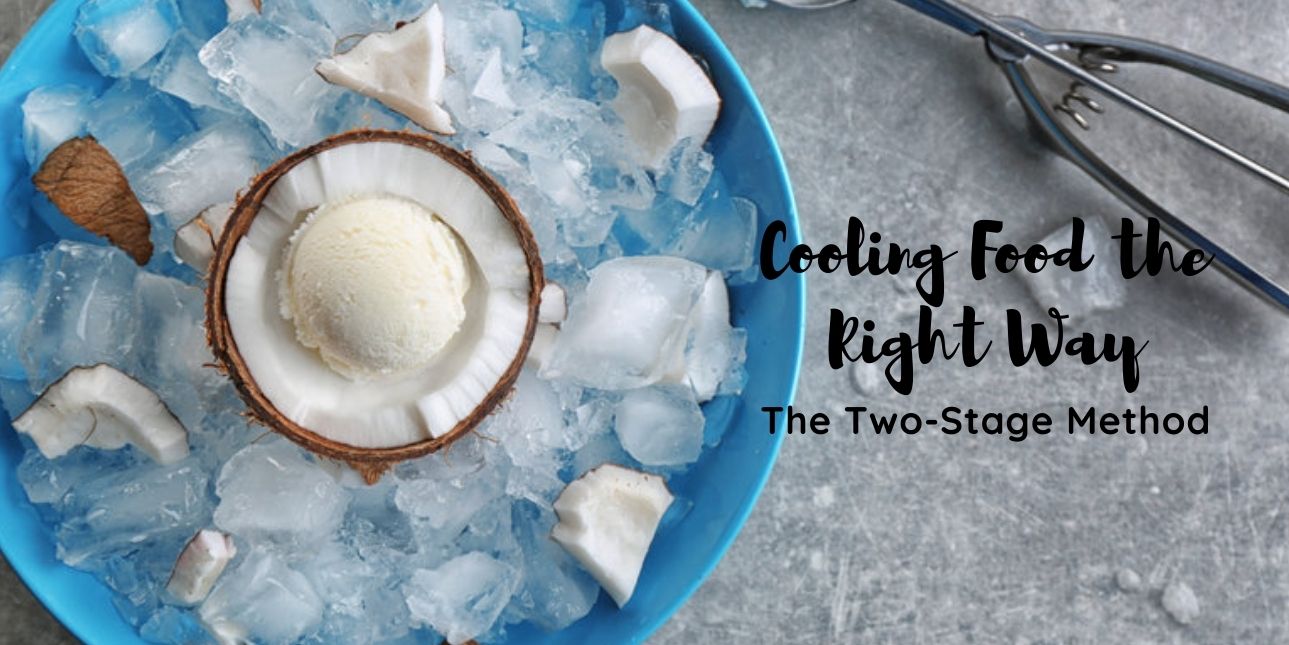
While cooking food forms one aspect of the core duties of a commercial kitchen, it’s also important to note that cooling food is another integral part of the operations in a food service establishment. Though several dishes are made to order in restaurants, a lot of foods are prepared beforehand and either chilled or frozen for the convenience of staff during high-volume periods. Food in small portions tends to cool fast, however, this isn’t the case with large batches of food. Large pots of soup or gravy can take several hours to reach ambient temperatures, and this puts the cooked food at risk of bacterial colonization.
Bacteria tend to replicate the fastest in certain temperatures and thrive. These temperature ranges need to be mitigated while cooling foods to avoid making them unfit for consumption. Though safely cooling food might not seem like a complex process, the procedure is quite technique sensitive and is vital to prevent food poisoning and other food-borne diseases that stem from stale food. The FDA’s food code recommends a two-stage cooling process to help restaurateurs safely cool foods to ensure their customers eat safe, clean, and healthy.
What’s The Bacterial Danger Zone?
Cooling food in an improper manner leads to bacterial growth and deterioration of food. If guests consume foods that aren’t cooled properly, they can become sick due to the pathogens in the food. It’s important to note that the cooling process involves several temperature ranges, some of which promote microbial growth and proliferation. Bacterial colonies tend to double between 135 degrees Fahrenheit and 41 degrees Fahrenheit. This temperature range is called the bacterial danger zone since it’s the ideal temperature for several species of bacteria to colonize food. Certain foods are more susceptible to bacterial growth, and these include protein-rich foods such as meats and lentils, fluid-based foods such as soups and gravies, and carbohydrate-rich foods like pasta and rice.
Why You Should Cool Hot Food Quickly
The food cooling process needs to be expedited to prevent bacterial growth and limit the amount of time the food spends in the bacterial danger zone. A rapid fall in temperature is not conducive to microbial infestation, and a quick cooling process ensures food safety until it can be reheated before it’s served to your customers. However, not all cooling methods are ideal, and the FDA recommends a two-stage cooling process to ensure the food you prepare is cooled the right way. So which methods for cooling foods should not be used by your establishment? Contrary to popular belief, placing hot food in the fridge is detrimental to both the prepared food and the refrigerator itself. The temperature in the fridge will instead promote increased bacterial growth and make the food stale. Ambient temperatures in the fridge will also rise due to the heat from the food, and cause the compressor to exert itself and damage your refrigerator. Higher ambient temperatures also put other foods at risk, and potentially compromise your entire storage facility.
Factors That Influence Cooling Food
Since not all foods, containers, or equipment are identical, various factors influence how foods are cooled. Here are the factors that influence the food cooling process:
- Size of Containers: Food in large containers takes longer to cool.
- Food Viscosity: Thick food takes longer to cool due to the higher density of the material.
- Refrigerator Capacity: Large commercial refrigerators and freezers have more powerful compressors when compared to domestic models.
- Container Material: Different materials have varied properties when it comes to temperature. While materials like plastic and other polymers tend to insulate and hold onto heat, steel, copper, and other metals are capable of both gaining, and losing heat very quickly.
- Processes: Processes like stirring and distributing food into small batches can promote faster cooling due to rapid heat loss.
The Two-Stage Cooling Method
Food has to be cooled in two stages to ensure the food traverses the bacterial danger zones quickly and is frozen the right way. The FDA recommends cooling food in two different steps to ensure the food you store is safe to serve. Here’s what you need to know about two-stage cooling for foods:
- The First Stage: Food must first be cooled from 135 F to 70 F under a span of 2 hours. Since this phase constitutes the riskiest stage where bacterial colonization is most active, cooling food should not be prolonged to ensure the food is safe to consume after being reheated. If the food is not brought to 70 F under 2 hours, the food must be quickly reheated to over 160 F, following which the cooling process can be repeated until the thermometer reads 70 F.
- The Second Stage: After the first stage, food must then be cooled from 70 F to 41 F under 4 hours. The monitoring of temperature and the process is integral to both stages. If proper temperature control methods are not adhered to, the food must be discarded to avoid contamination so your establishment can comply with the health codes set by the FDA.
Three Acceptable Methods For Cooling Food
Since placing hot food directly in the fridge is not an acceptable method, what is the best alternative to safely cool food? There are three acceptable methods to help you bring down the temperatures quickly and in a safe manner. Here are the best alternatives to safely cool foods instead of placing them in the fridge directly:
- Ice Cubes & Ice Baths
An ingenious method to cool food efficiently would be to add ice cubes to the food you cook and are trying to cool. This method is very effective for food that has a high amount of water content in it, specifically for dishes that are in a liquid or semi-liquid state. Soups, sauces, gravies, stews, and stocks can be cooled rapidly using ice. If you want to give these foods a thick consistency, you can either cook these foods thicker than usual or re-thicken them once you thaw them out so they return to their original consistencies and viscosities. You can split the food into separate batches, or stir them regularly to disperse the heat more effectively.
Another method that is very effective in rapidly bringing down the temperature of hot food is by immersing the pot, kettle, or vessel into an ice bath. If you’re worried about your food losing its consistency by adding ice directly to it, the ice batch food cooling technique is ideal. Begin by filling up a large pot with a small amount of water and proceed to add a large quantity of ice to the vessel. Place the food in a container in the ice bath, and ensure the level of the ice is above the level of food in the container while making sure the container is not submerged. Don’t forget to add more ice as and when required. Also, monitor the temperature regularly and stir the food around to disperse heat. Use a high-quality ice machine to make sure your establishment is always prepared to cool food using either ice or ice baths.
- Ice Paddles
Ice paddles are simple yet specialized devices to help you cool food very quickly. Ice paddles come with an internal canister that holds water. The paddle can be refrigerated and frozen so that the internal canister with water is frozen. This paddle is then inserted into the vessel with hot food so that the food can cool down as the user stirs the pot with the paddle. While you might have to freeze the paddle overnight, you can also fill it up with ice or cold water in case you have an urgent requirement. Since vessels often get cooler around the periphery first while the central portion still retains heat, ice paddles are ingenious solutions that allow you to cool food quickly and uniformly. Stir the food every two to three minutes and monitor the temperature using a thermometer to ensure the food comes down to 70 degrees in under two hours. You can place the pot of food in the refrigerator with the paddle within the vessel to ensure the second stage of cooling occurs within four hours.
- Blast Chillers
Blast Chillers are high-tech refrigerators that enable you to cool food rapidly. These machines use cold air to ensure the food cooling process happens safely. Blast chillers also prevent the formation of ice crystals due to the rapid dip in temperatures within the machine. You can use a blast chiller to cool your food safely by splitting your cooked food into smaller, manageable batches. Fill up shallow food pans, and make sure the food level is not beyond 3 to 4 inches. Place these pans in the blast chiller and allow the temperature to drop to the desired levels within the safe time frame.
Institute Safe Cooling & Maintain Cooling Logs
Since you alone cannot manage the entire cooling process of all the food in your business, it’s important to ensure your staff is well trained in safe cooling techniques. If they’re not familiar with the safety guidelines instituted by the FDA for cooling food, make sure you train them in the two-stage cooling process along with the usage & calibration of a thermometer. Don’t forget to institute a cooling log and a labeling system to monitor your staff’s cooling duties in the kitchen. Put in place a strict practice so that everyone in the kitchen abides by the food cooling process to ensure your customers have safe and healthy meals. Instruct your restaurant managers to keep a track of the cooling log every day, and conduct regular reviews of cold storage to keep a check on stored items.











